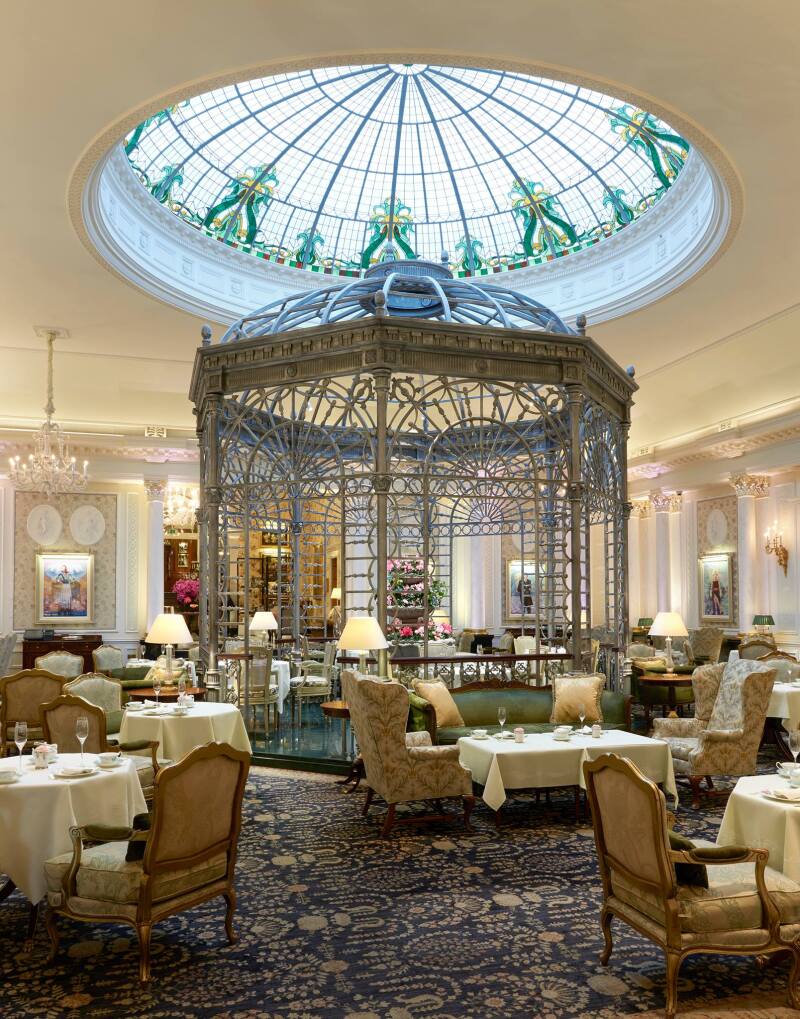Glorious leader? Colonial tyrant? Whatever your opinion of Queen Victoria, there’s no denying that her 63-year reign left a lasting impression on London: her empire’s epicenter. It’s hard to imagine the city’s skyline without the ornate Victorian exteriors of the Albert Hall, the Natural History Museum, or the Palace of Westminster. And London just wouldn’t be London without its scores of other classic Victorian buildings—hotels, galleries, and department stores where 19th-century celebrities, wits, and intellectuals once visited. In homage to this iconic era, take a nostalgic tour of the British capital with an eye on the Dickensian, the Wildean, and, of course, the Beef Wellington.
Café Royal
Recently converted into a five-star hotel, Regent Street’s Café Royal was one of London’s most coveted Victorian restaurants. Built in 1865, this historic listed building (owned by Queen Elizabeth II) was a refuge for bohemian bon vivants like Paul Verlaine, Arthur Rimbaud, and Oscar Wilde. Party like a rakish playwright in the Green Bar and order an Absinthe Bohemian with lemon juice and fresh mint.
Royal Opera House
Even if Mozart is not your cup of Earl Grey, it’s still worth visiting the eminently Victorian Royal Opera House, opened in 1858. Nibble on seasonal canapés at Paul Hamlyn Hall Champagne Bar, an iron and glass dome with unrivaled views of Covent Garden’s main square. Then, if the mood strikes, head to the auditorium for 19th-century classics and contemporary productions.

Afternoon tea in the Thames Foyer at The Savoy
Courtesy of The Savoy
The Savoy
Established in 1889, The Savoy attracted a stellar clientele, including the Prince of Wales and the (then) soon-to-be King Edward VII. Partly funded by profits from Gilbert and Sullivan’s wildly popular 1885 comic opera The Mikado, this palatial West End hotel is now also home to Gordon Ramsay’s Savoy Grill. Try its twist on the traditional Sunday roast: Beef Wellington with horseradish cream and truffle jus.
William Morris Gallery
A legend of Victorian textile design, William Morris believed that you should “have nothing in your house that you do not know to be useful, or do not believe to be beautiful.” Located in the artist’s opulent former residence, the William Morris Gallery is a testament to that belief. Marvel at Morris’s furniture, wallpaper, and ceramics, and then head next door to the glass-vaulted Tea Room for freshly baked scones with clotted cream and strawberry jam.
Simpson’s-in-the-Strand
One of Charles Dickens’s favorite haunts, Simpson’s-in-the-Strand also features in E.M. Forster’s turn-of-the-century novel, Howard’s End. The staunchly British, meat-heavy menu hasn’t changed much since it opened in 1828. Try the steak-and-kidney pudding for lunch or the grilled Dover sole for dinner.
Tate Britain
Tate Modern’s lesser-known older sister, Tate Britain is a treasure trove of Victorian art. Opened in 1897, the high-domed building houses a permanent collection of classic British artists, including Joseph Turner, William Holman Hunt, and John Constable. Until May 7, 2018, Impressionists in London exhibits London-themed paintings by Claude Monet, Camille Pissarro, and James Tissot. Don’t miss the “Lunch and Impressionists” promotion at the gallery’s award-winning Rex Whistler Restaurant. The offer includes access to the exhibition and a menu of French-inspired dishes like terrine de foie gras and tarte tatin.

The Theatre Royal Haymarket
Courtesy of the Theatre Royal Haymarket
Theatre Royal Haymarket
Listed as a London landmark, the Theatre Royal Haymarket is the ideal locale for a culture fix. Oscar Wilde’s first comedy, A Woman of No Importance, premiered here in 1893. Contact the box office to book a champagne reception in the Oscar Wilde Room, where the writer purportedly entertained his guests.
Savini at Criterion
In Sir Arthur Conan Doyle’s A Study In Scarlet, Dr. Watson meets Sherlock Holmes after dining with a friend at The Criterion. Opened in 1873, the restaurant’s burnished gold interior is the perfect setting for a London murder mystery. The Criterion changed ownership in 2015; it’s now the London outpost of the upscale Milanese restaurant, Savini. Order the three-course Theatre Menu, then swish next door for a show at The Criterion Theatre, a triumph of Victorian architecture.
Liberty
Subtly superior to the well-trammeled halls of Harrods, Liberty was the Victorian lady’s department store of choice. Today, scour the elegant, oak-paneled halls for carefully curated jewelry and accessories like Alexander McQueen fringed woolen capes, Oscar De La Renta silk-and-bead earrings, and Stella McCartney vegan-friendly, faux leather shoulder bags.
Hatchards
Full disclosure: London’s oldest bookstore, Hatchards, was built in 1797 and therefore is Georgian, not Victorian. But prominent Victorians like Benjamin Disraeli and Lord Wellington were regular clients. These days, rare books are Hatchard’s specialty. Pick up a coveted first edition by T.S. Eliot, D.H. Lawrence, or Iris Murdoch or a signed novel by Ruth Rendell, Stephen Fry, or Ian McEwan.
>>Next: Claridge’s New Cookbook Holds the Secrets of London’s Grandest Hotel











